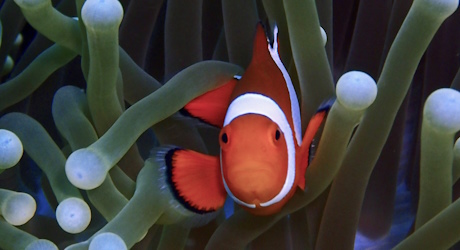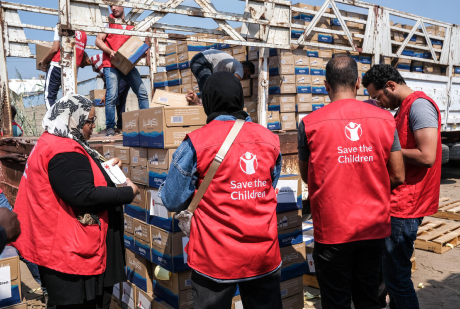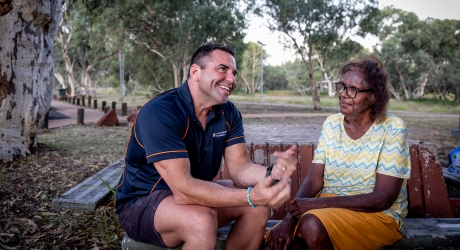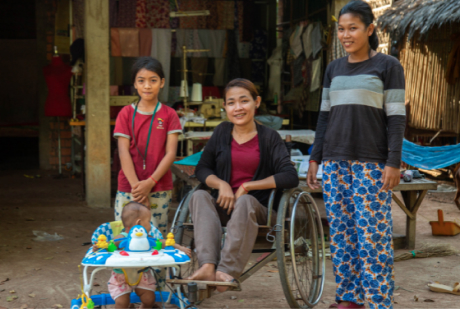Footprints Project
Since 2005, travelers like you have helped us change the world through micro-donations.
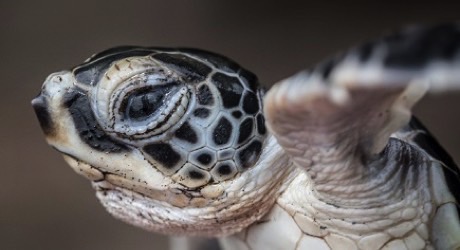
-
A total of
11034
Travelers
-
donated
$25008.68
(100% funded) -
to help improve
Environment
-
impacting
200
people -
in
Costa Rica
Project background
Tortuguero Beach, located on the Caribbean coast of Costa Rica, hosts the largest green turtle rookery in the Western Hemisphere. For 60 years, Sea Turtle Conservancy (STC) has conducted an annual research and conservation program at Tortuguero, which has achieved phenomenal success at increasing sea turtle population levels and replacing the consumptive use of sea turtles with sustainable ecotourism.
Despite this history of achievement, the sea turtle species nesting at this beach still face numerous threats, one of the most pressing of which is climate change and the toll it is taking on the reproductive success and survivability of green turtles. One of the key ways rising temperatures impact sea turtles is in the ratio of male and female hatchlings being produced (warmer temperatures produce mostly female turtles).
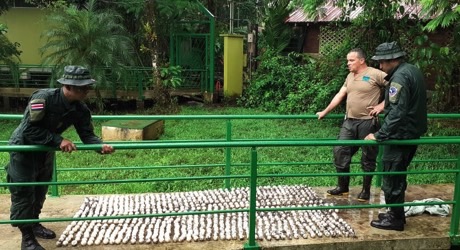
Project goals
- Goal #1: Monitor three sea turtle species nesting at Tortuguero and determine long-term population trends and survival threats.
- Goal #2: Record sea turtle nest temperature and utilize a new, non-lethal technique to determine the sex of Tortuguero’s green sea turtle hatchlings.
- Goal # 3: Reduce human impacts on Tortuguero’s sea turtles and the coastal and marine environments critical to the survival of these species.
- Goal # 4: Work with local communities and vendors to put in place and maintain eco-tourism opportunities that attract conservation-minded tourists who want to experience sea turtles in the wild.
Project results
Goal #1
A rigorous research and monitoring program was carried out at the Tortuguero nesting beach throughout the leatherback and green turtle nesting seasons. The leatherback season ran from March through June and the green turtle season ran from June through December. In 2019, STC recorded 263 leatherback nests on Tortuguero Beach, which is the highest amount of leatherback nests recorded since 2007. STC recorded 129,660 green turtle nests on Tortuguero Beach, which is more than double what STC recorded in both 2017 and 2018.
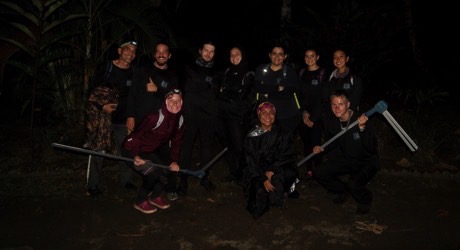
One challenge STC has faced in the past near-decade in Tortuguero is the slow decline of green turtle nesting. Along with the harvest of thousands of green turtles in Nicaragua, illegal poaching of turtles and eggs in Tortuguero has increased recently due to an influx of new residents who are unaware of the culture of sea turtle protection in Tortuguero. To address this issue, STC will continue to maintain its presence on the beach, relationship with enforcement agencies and outreach efforts within the Tortuguero community.
Goal #2
In 2019, STC created a database of average nest incubation temperatures and compared data with previous studies at Tortuguero to get a better idea of the sex ratio produced on this beach. Among the 41 green turtle nests tested, we found that the 2:1 female to male sex ratio first documented in 1977 has not changed significantly. Because the feminization of important sea turtle rookeries is a potential impact of climate change, STC will continue to monitor nest incubation temperature in order to develop future mitigation strategies.
STC also collected samples from select hatchlings to determine their sex using a non-invasive technique; we are currently in the process of obtaining the Convention on International Trade in Endangered Species (CITES) permit needed to send the samples to our Scientific Director’s lab in the United States to analyze the data. Once the permit is approved and the data is analyzed, STC will begin to form a baseline percentage of male and female hatchlings produced on Tortuguero Beach. This information will have broad conservation and management implications as sand temperatures rise with climate change.
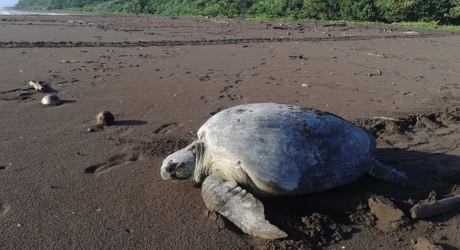
Goal #3
STC continued to reduce human impacts on Tortuguero’s sea turtles through the implementation of its annual monitoring program, which has been developed to facilitate an accurate evaluation of the impact of different threats and allows threat trends to be rapidly identified so that appropriate measures can be taken. During the 2019 green turtle nesting season, STC had the opportunity to work directly with law enforcement personnel to try to mitigate the impacts of poaching.
In August, STC research coordinator Jaime Restrepo was contacted by local policemen who had confiscated several bags containing nearly 1,000 green turtle eggs taken from poachers spotted leaving the beach. Working quickly but delicately, STC staff reburied the eggs by re-creating eight turtle nests in a safe location near STC’s research station.
Because of STC’s longstanding presence in Tortuguero and close relationship with law enforcement, more than 800 sea turtle eggs were saved from being eaten and were given the opportunity to hatch. To address predation of nests and turtles by domestic animals, STC hosted its free spay and neuter clinic in the community. More than 80 dogs and 45 cats were sterilized for free, which was a new record for STC and highlighted the popularity of the program.
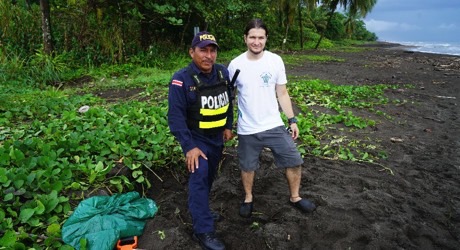
STC also remained in close communication with the local utility company to address the use of white, unshielded street lights near the beach in Tortuguero. Due to budget and bidding concerns, the start date of the transfer to turtle-friendly lighting has been pushed back several times. Although the project has experienced delays, STC has clearly communicated that the use of long wavelength and shielded fixtures is the best option for sea turtles.
We are confident that once internal delays are complete, the correct lighting will be installed and sea turtle disorientations will decrease on Tortuguero Beach. In the meantime, STC’s RAs and Junior RAs developed incentive programs to turn off or shield problematic lighting on private businesses and residences, which has helped to reduce light trespass on the beach. Using a light meter, the Junior RAs were able to measure a decrease in the intensity of light trespass onto the beach after the shields were installed.
Goal #4
More than 117,000 tourists visit Tortuguero each year to witness sea turtles nesting. STC takes every opportunity to inspire environmental stewardship that we hope will result in the long-term protection and recovery of sea turtles. Nearly 20,000 people visited STC’s Visitor Center alone, where STC provided 48 talks about sea turtle biology and STC history. Dozens of local tour organizations also made stops at STC’s Visitor Center, highlighting STC’s elevated presence in the Tortuguero community.
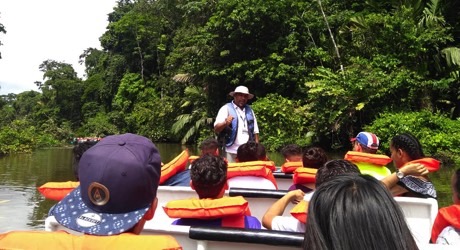
STC provided hands-on educational outreach to students of a local high school and middle school in Tortuguero. Despite living in areas surrounding Tortuguero National Park, most high school students in Tortuguero have never visited the park or taken a canal boat tour. STC’s hosted educational tours for high school students who were just about to graduate in order for them to experience Tortuguero’s diverse environment and learn how to take care of it.
STC successfully managed the Turtle Spotters Program and added an additional spotter at each section of the beach, which helped to more evenly distribute the tour groups. This strategy allowed for tourists to passively interact with Tortuguero’s sea turtles at a safe distance while reducing the impact on the turtles.
STC continued its highly successful Eco-Labeling program, which inspires local businesses to change their lighting, waste separation methods and single-use plastic consumption in order to receive recognition from STC. In 2019, 22 hotels and restaurants received a “gold” label and 16 other businesses received a silver or bronze label. Each business was recognized with a sign displayed in its window and a public award ceremony to celebrate their efforts. By educating local businesses about turtle-friendly practices, RAs enacted positive conservation change and created buy-in within the community.
In late August, STC placed satellite transmitters on three green sea turtles and publicly released them outside the Tortuguero station as part of its annual Tour de Turtles program. Sheldon, one of the turtles satellite-tagged in Tortuguero, travelled 2,563 km in three months and won the Tour de Turtles race. The other two turtles, Mei Mei and Sage, are currently tracking off of the Miskito Coast of Nicaragua, where the poaching of adult turtles in the water is prevalent. STC believes that real-world education programs such as the Tour de Turtles are one of the most important tools for the long-term recovery of sea turtles.
Watch: Turtle Conservation in Costa Rica
A short video from World Nomads on the work STC is doing in Tortuguero and how tourism is positively impacting this important turtle nesting site.
What next?
The work at Tortuguero represents a long-term commitment by STC to monitor and protect this critical nesting beach in partnership with the local community. We foresee the program continuing indefinitely as we continue to protect and recover this globally important population of green turtles.
Traveling soon? When you buy travel insurance with us, you can make a contribution towards a cause you care about.
Get a quote